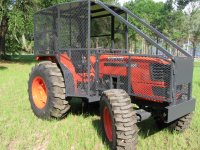newbury
Super Star Member
- Joined
- Jan 8, 2009
- Messages
- 14,188
- Location
- From Vt, in Va, retiring to MS
- Tractor
- Kubota's - B7610, M4700
These forestry clearing saws will cut a lot of stuff and much easier than bending over with a chainsaw.
Object moved
I have the FS 350 model with a brush/weed blade, chainsaw type blade, and a normal saw kerf blade. They come with a shoulder harness that supports the saw's weight. 2"-3" trees are no problem for mine. I use it to keep walking trails too narrow for the tractor clean. It's my lawn grass whipper too with a string head.
Judging by what the 350 model can do, the 560 would be a serious cutting machine. They are used by forestry crews to thin tree stands and remove unwanted species.
I've got the FS250 w/ brush blade and find that using my 60cc chain saw with a 30" blade and swinging it like a hedge trimmer is easier than cutting much above waist level with the FS250. Maybe I just don't have the right "swing" with the FS250. Now for every thing waist level and below it works well.
It also may depend on the density of the branches, I was doing stuff dense as a privet hedge w/ diameters up to several inches.
If the OP is only cutting at ground level then the brush cutter would be best.

